

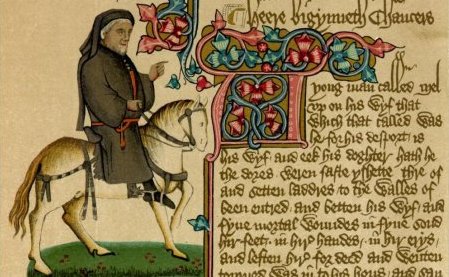
The Canterbury Tales, written by Geoffrey Chaucer at the end of the
fourteenth century, have been read with admiration in most periods
between the fifteenth century and the present. In this poetic satire, Chaucer
uses "a fictitious pilgrimage as a framing device for a number of stories"
(Norton, 79). Chaucer himself becomes a character, and at the same
time, the narrator in this masterpiece, and along with twenty-nine other people,
he sets out on the quest to Canterbury. In "The General Prologue," Chaucer
presents short descriptions of each of the pilgrims. Throughout the poem,
Chaucer the narrator depicts the pilgrims one by one, without criticizing
or telling the reader his own opinion about the characters: he
leaves that up to the readers to perceive on their own.
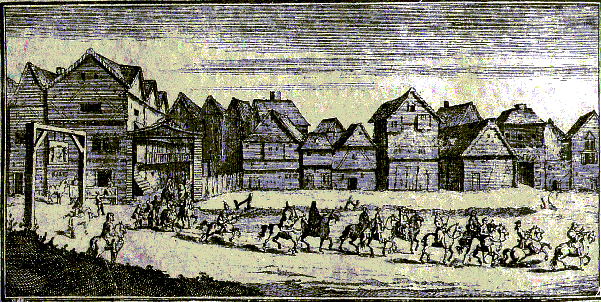 Pilgrimages were very common in fourteenth-century England, and they were
well depicted in the Middle English literature. On the literal level, the pilgrimage
was a journey to the shrine of a saint to pray and receive remission
for the sins, and while on the pilgrimage, one would meet
different people and listen to their interesting stories.
On the allegorical level, the pilgrimage represents people's
journey through life. In The Canterbury Tales, after setting themselves
to leave from the courtyard of the Tabard Inn, the pilgrims agree to
tell the stories: two on the way to Canterbury and two on the way back.
Such a development of the plot gives Chaucer a chance to portray each of the
pilgrims through his or her own lips.
Pilgrimages were very common in fourteenth-century England, and they were
well depicted in the Middle English literature. On the literal level, the pilgrimage
was a journey to the shrine of a saint to pray and receive remission
for the sins, and while on the pilgrimage, one would meet
different people and listen to their interesting stories.
On the allegorical level, the pilgrimage represents people's
journey through life. In The Canterbury Tales, after setting themselves
to leave from the courtyard of the Tabard Inn, the pilgrims agree to
tell the stories: two on the way to Canterbury and two on the way back.
Such a development of the plot gives Chaucer a chance to portray each of the
pilgrims through his or her own lips.
Chaucer's pilgrims represent all the social levels of the
hierarchical order of medieval society. Most of the pilgrims are men.
There are only a few women, and one of them is the Wife of Bath.
She is depicted by Chaucer in "The General Prologue" as a "somewhat deaf,"
red-faced and "gap-toothed" woman who has her own business as a weaver of
cloth. To show everyone in the town that she is well off, when she goes to church
on Sundays, the Wife of Bath -- Dame Alisoun - overdresses: she wears a skirt
and red stockings, wuth ten pounds of "coverchiefs" and tight-laced supple shoes:
"Her wearing of such garments stamps her as the most prosperous woman of
business, and naturally she takes pleasure 'to se, and eek for to be seye'
as she later tells us" (Parker).
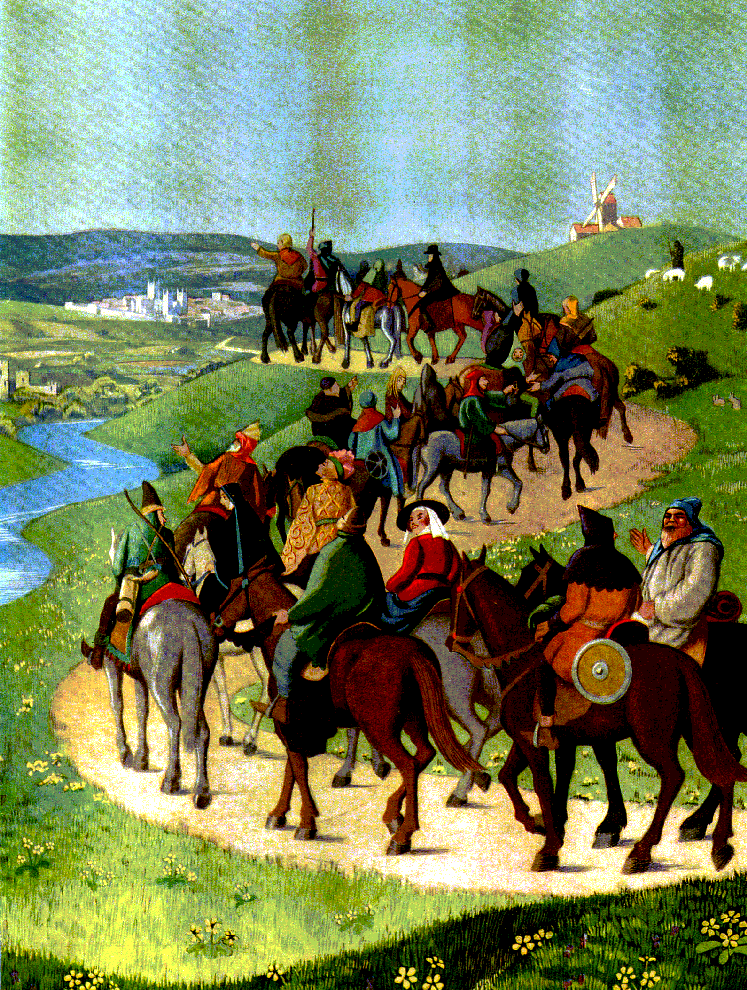 The Wife of Bath makes it a point to be the first one to give her offerings
at church and refuses to give them if anyone else does it before her.
Today's reader might not consider this little detail seriously, but
Chaucer's contemporaries would have certainly understood such a desire to
be noticed. David Parker says about the Wife: "… the fact that the
Dame Alisoun is so wrathful that she is 'out of alle charitee' when someone
usurps what she considers to be her rightful place is an indication, not
of conceit, but of the frank pride in achievement."
The Wife of Bath makes it a point to be the first one to give her offerings
at church and refuses to give them if anyone else does it before her.
Today's reader might not consider this little detail seriously, but
Chaucer's contemporaries would have certainly understood such a desire to
be noticed. David Parker says about the Wife: "… the fact that the
Dame Alisoun is so wrathful that she is 'out of alle charitee' when someone
usurps what she considers to be her rightful place is an indication, not
of conceit, but of the frank pride in achievement."
The Wife of Bath is presented to readers in "The General Prologue" as a devoted
pilgrim who has made three trips to Jerusalem and has been to Rome as well
as to several other shrines in different countries. Since in the Middle Ages
women were to be governed by their husbands and were encouraged to stay home,
the only way a woman might leave her house was to go on pilgrimage. Alisoun
has been married
five times and "knows the remedies of love." Chaucer finishes Wife's
description by saying: "She was a worthy womman al her live"(Norton, 92).
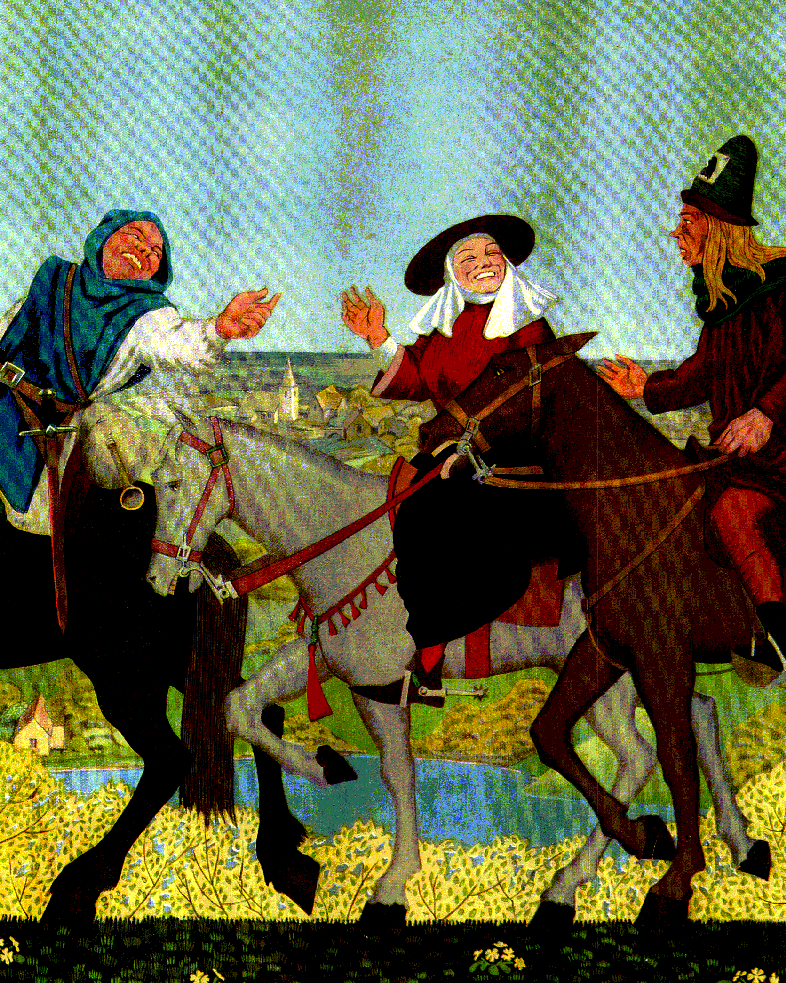 The way that the Wife of Bath dresses and behaves suggests the directness
of her character. Before telling her story, she gives a little of her
autobiography in "The Wife of Bath's Prologue." She believes in experience --
not authority. She was married for the first time when she was twelve and
has had four more husbands since. In fact, she met her fifth husband at the funeral
of the fourth. She tells us that she noticed the nice legs of the man
that was carrying the coffin. Now, on this pilgrimage, Alisoun is looking
for her sixth one:
The way that the Wife of Bath dresses and behaves suggests the directness
of her character. Before telling her story, she gives a little of her
autobiography in "The Wife of Bath's Prologue." She believes in experience --
not authority. She was married for the first time when she was twelve and
has had four more husbands since. In fact, she met her fifth husband at the funeral
of the fourth. She tells us that she noticed the nice legs of the man
that was carrying the coffin. Now, on this pilgrimage, Alisoun is looking
for her sixth one:
Despite the probable disapproval of her story by most of the
pilgrims, the Wife of Bath finishes one argument while starting another:
Considering herself an expert on every topic, Dame Alisoun continues
her arguments by stating her point of view on
marriage.
She knows that
church and society state that the wife is to be obedient to her husband. She
is aware of what is going on around her, but she is proud to say that she has
claimed sovereignty over all of her five husbands. She says that three of
them were old and rich and two young and wild. The most interesting is the
story of the fifth husband, Janekin. He used to read to her from his book
of wicked wives, showing off his education and asserting his
dominance over his wife. One day, in frustration and anger, the
Wife of Bath rips out three leaves from that "cursed book" as Janekin is
reading, and they get into a fight. This gets physical and messy, but
afterward, they enter a new level in their relationship where the wife gets
what she is aiming for -- complete sovereignty over her husband.
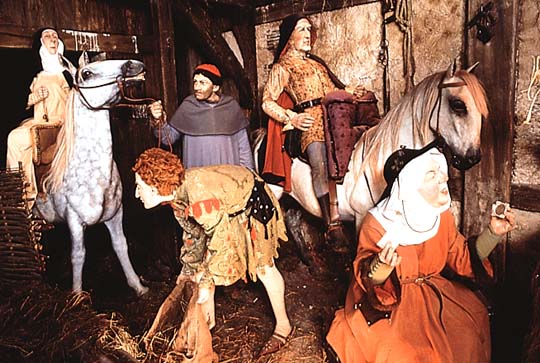
The Wife of Bath is a vivid and lively character in The Canterbury
Tales. Her tale starts a "new chapter" in the poem. Since she touches the
subjects that were forbidden (such as sex) and painful(women's equality to man)
to the church and society, the
tales that are told by the pilgrims after "The Wife of Bath Tale" reflect
to certain degree the started topic. It becomes obvious that the Wife of Bath's
aim was not so much the truth, as it was her self-justification. Created
by Chaucer in the end of the fourteenth century, the "lusty and domineering"
character of the Wife of Bath seems to be more alive today as a prototype of a
liberated woman than she was during the Chaucer's time.
By creatign this character, Chaucer attacked the existing patriarchal
hierarchical social order and raised the
question of
women's equality to man by placing the woman on the position
historically given by society to men.

